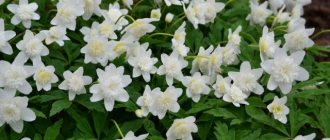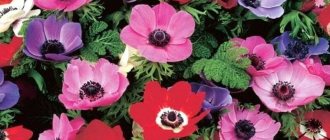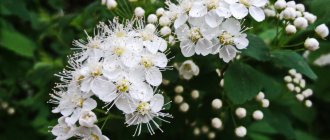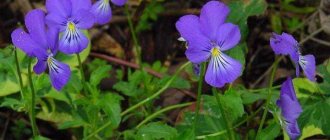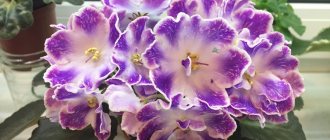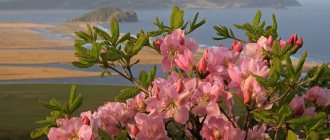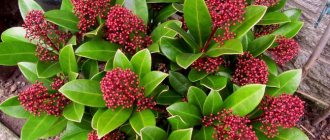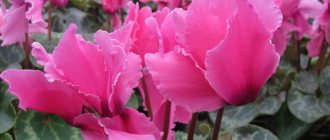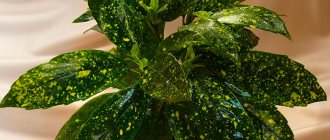Japanese anemone is a representative of perennial plants belonging to the genus Anemone, the Ranunculaceae family. The plants are garden plants and grow mainly in areas with moderate climatic weather conditions. A distinctive feature of the culture is a fairly high level of frost resistance, as a result of which flowers can be grown, if necessary, even in those areas where severe winters are observed. Despite this, the flowers are quite fragile and have an attractive appearance. Today, there are a large number of varieties of Japanese Anemone. In order for flowers to delight you with their appearance, you need to know how to plant and care for plants.
Description of Japanese anemone
Japanese anemone is a rather delicate crop belonging to the Ranunculaceae family. Today there are more than 100 varieties of culture. Despite this diversity, all existing Anemone species share common characteristics. A distinctive feature in this case is a fairly strong and slender stem, the height of which can reach 1 m. The leaves are of a rich shade; no support is required.
The bud includes from 4 to 20 petals. After the flowering period, you can observe the appearance of fruits that resemble nuts in appearance. It is important to take into account the fact that plants belonging to the Buttercup family are poisonous. That is why, if juice gets on the skin, a burn may occur.
Types
When I was choosing what to plant on the plot from the variety in question, I was simply shocked by the abundance of subspecies. Basic:
- Pamina - blooms early, usually does not reach more than a meter in height. The main flowering period is mid-summer. The flowers have a very rich shade, so they look elegant and become the main decoration of the garden.
- Profuzhn is an anemo-hybrid about 120 cm in height. During active flowering, it becomes dark purple, the flowers are double and velvety. The main flowering occurs in August-October.
- WilWind is a variety with high decorative qualities and very beautiful leaves in the root zone. The foliage is large, the edges are jagged. An adult bush is 80-100 cm in height. The flowers are white, but the stamens are yellow, collected in inflorescences of up to 15 pieces. The main flowering time is August-September. The variety is unpretentious in care.
- Prince Henry - stately beautiful plants, the bushes grow quite tall, the leaves are beautiful, large. Up to 15 pieces are collected in inflorescences, the shade is bright red. The main flowering time is August.
- September Charm - charming plants about 130 cm in height, graceful, carved leaves. Flowers of a soft pink hue bloom towards the end of summer.
All types are very beautiful and interesting. If space on the site allows, you can plant several different options at once.
Varieties and varieties of Japanese anemone
As mentioned above, culture includes a large number of varieties. Each variety has a number of features, advantages and disadvantages that must be taken into account before making a purchase. Despite this diversity, several varieties remain popular, which many experienced gardeners recommend considering first.
Attention! If necessary, you can see what Japanese Anemone flowers look like in the photo.
Hubei Crispa
Hubei Crispa is an Anemone variety distinguished by the unusual beauty of its foliage. In the summer, corrugated leaves appear, resembling parsley in appearance. The leaves are a rich light green color with a cherry rim around the edge. During the flowering period, pink buds appear, the diameter of which reaches 8 cm.
Wil Wind
If necessary, you can find Japanese Anemone of the Vetrennitsa variety for sale on the market for goods and services. As you know, the name of the variety means “whirlwind”. Often this variety is sold under several names - Vil Wind, Velvind, Vilvind. The culture is capable of growing up to 1 m in height. During the flowering period, semi-double white flowers with golden stamens appear. Flowers are collected together in approximately 10-15 pieces.
Prince Henry
Prince Henry is another variety of Anemone japonica. During the flowering period it bears a large number of semi-double flowers. The buds of the culture are painted in a rich pink hue. Each flower consists of about 10-15 sepals. A distinctive feature is the rather abundant and long flowering period of the plants.
Honorine Jobert
Another variety that is popular today is Japanese Anemone Honorine Jobert. This culture can be found on sale under the name Honorine Jobert. The crop is of medium height, as a result of which it can reach a height of 80 cm. The leaves are quite large and dissected, and have a rich gray-green hue. Honorine Jobert's flowers are simple, snow-white with yellow stamens.
Anemone Lady Julia
Anemone Lady Julia is a new variety of Anemone japonica. During the flowering period, flowers of a rich pink hue appear on the plants, while the buds are semi-double. In the center of the flower there is a yellow core. The flowering period begins at the end of summer and continues until the very end of autumn, flowering is abundant. The bushes are small in size, capable of reaching a maximum height of 60 cm.
Advice! It is best to plant the crop in a place where there is no direct sunlight.
Robustisima
As practice shows, the Robustisima variety is significantly different from previous varieties of flowers. This difference is not surprising. This is primarily due to the fact that Robustisima belongs to the Anemone tomentosa, a distinctive feature of which is the presence of leaves that are pubescent from the lower part. The flowers are simple, deep pink. In appearance they resemble dahlias of the Merry Guys variety. It is impossible to call the bushes miniature, since the height can vary from 1 to 1.2 m, while the buds are small.
Some varieties
- Pamina is an early flowering plant, sometimes reaching 90 cm in height. It begins to bloom in July. The flowers are burgundy or sometimes a very dark red. This variety is very popular in flower beds and flower beds, for the reason that it requires almost no care.
- Profuzhn is a hybrid variety. Its flowers are purple double, and the flowering period is from late summer until October. It is believed that this breed is autumnal. Like many hybrids, this anemone is quite tall. Its bushes sometimes grow up to 1.2 m.
- WilWind differs from others in its decorative basal leaves with a serrated edge. The flowers are white or yellow with many stamens and form inflorescences of 10-15 each. It blooms, like the previous variety, at the end of summer.
- Prince Henry is a bush with beautiful leaves. It is similar to WilWind, but its flowers are bright red. This plant blooms in the same way as the previous variety, from the end of summer.
- Queen Charlotte attracts gardeners with its three-lobed leaves and large double light pink flowers.
- The September Charm variety is translated as “the charm of September.” This plant has large, bright leaves of the same shape as the previous variety, but differs in its delicate pinkish-colored flowers. It naturally blooms in late August – September.
Care for each variety is almost the same.
How to plant Japanese anemone in the garden
Japanese herbaceous anemone is a plant for open ground, as a result of which the planting process must be treated as carefully as possible. In the first place is the correct selection and preparation of the seat. As practice shows, the culture is unpretentious in care, as a result of which even novice gardeners should not have problems with cultivation and further care.
Site selection and soil preparation
Due to the fact that Japanese Anemone is planted in open ground, it is necessary to take the most responsible approach to choosing a planting site. It is best to choose an area that is protected from strong gusts of wind; an excellent solution would be to plant the crop under tall shrubs or trees with a spreading crown. The culture feels great in partial shade or where direct sunlight does not reach, as a result of which the delicate petals will not be scorched.
Attention! Anemones are able to grow in one place for a long time and do not tolerate the transplantation process.
Planting anemones with tubers
Planting Japanese Anemone with tubers is usually carried out in the spring; if necessary, this procedure can be carried out in the fall. The first step is to dig up the soil and remove weeds along with stones. Many experienced gardeners recommend pre-applying mineral fertilizers, organic matter, and sprinkling the ground with wood ash or lime. When planting in groups, there should be plenty of space between the bushes for free growth.
Advice! Planting depth is 5 cm
Planting anemone seeds
If you plan to plant plants with seeds, it is recommended to first place the planting material in wet sand for a while, which ensures the swelling process. After this, the sand is mixed with peat and planting is carried out. As soon as the first shoots appear, you should start hardening the seedlings. If proper care is provided, the Anemone will bloom in the same year.
Important! Carry out the process of planting Anemones in Japanese autumn.
How to properly care?
Caring for anemone when grown in the Moscow region is not too difficult. It will only be necessary to systematically moisten the temporary soil until the time comes for transplanting into open ground. Then the seedlings are protected:
- straw;
- sawdust from deciduous trees;
- dried leaves;
- coniferous paws.
Top dressing
In the autumn months, the ground around the anemone is saturated with organic mixtures
Important: all varieties of this plant react extremely negatively to the introduction of manure. If compost is used, it is only from the leaves of fruit crops.
To improve the result, mineral compositions are used, including magnesium and potassium. If flowers and stems develop normally, no additional measures will be needed.
Watering
Anemone should be watered in the fall only as needed. And this “need” occurs maximum once every 7-8 days. If there is too much water, the plant may die. This approach should be practiced both in relation to seedlings and in relation to adult specimens. Other requirements are:
- In spring, anemones need to be irrigated weekly;
- in the summer they do this twice or thrice a week;
- in hot weather, the plant is watered at the root in the morning and evening hours;
- Stagnation of water should not be allowed.
Wintering
It is necessary to specifically dig up an anemone and move it into the house only if very severe frosts await. Under normal conditions, horticultural measures to protect against soil freezing are sufficient. The necessary protection will be provided by:
- thick layers of dry herbs;
- unnecessary branches;
- spunbond;
- agrospan;
- spantex.
You need to dig up and transfer into the house those varieties of crops that bloom and die after the formation of seeds. For winter storage in the house, you need to choose a place that is not constantly exposed to dampness. Otherwise, the plant may rot before it reaches spring. But drying is also contraindicated - it is better that the humidity is relatively balanced. Exposure to extreme cold is also unacceptable, so storing anemones in the basement is not a good idea.
Mulching
Oak, linden and apple leaves are ideal as mulch. At the same time, they try to reproduce the natural forest floor as much as possible. Compost, loosened peat or humus are often used for mulching. The procedure is repeated until active growth begins. In autumn, mulching is carried out with herbal compost.
Caring for Japanese anemone
As practice shows, a distinctive feature of culture is unpretentiousness in care, and this is undoubtedly true. In order to see the beauty of plants in full force, you will need to provide proper care, namely, irrigate the soil in a timely manner, apply fertilizers at least 3 times during the season, remove weeds, loosen and mulch the soil.
Watering
A distinctive feature of the crop is its minimal watering requirements. In the spring, irrigation should be carried out once every 7 days and only if there has been no precipitation for a long period of time. In hot summers, watering should be more frequent, but in small quantities. It is important to understand that the root system is located in the upper layers, as a result of which moisture loss occurs as quickly as possible; in addition, the roots cannot take moisture from the lower layers.
Important! It is not recommended to loosen the soil in close proximity to Japanese Anemone; it is recommended to mulch the soil.
Top dressing
Often the Japanese Anemone flower grows without fertilizing, as a result of which it is impossible to see the crop in all its glory. It is recommended to apply fertilizer at least 3 times during the season:
- In spring, when the first green leaves begin to appear. In this case, organic is perfect.
- During the formation of the first buds, mineral complex fertilizers are applied.
- In the second half of September, any type of fertilizer that does not contain nitrogen is applied.
This is the only way to see all the beauty of flowers.
Shelter for the winter
In the southern regions, the crop does not need shelter. All that is required is simply to cover the plants with a thin layer of mullein. This approach is more of a precautionary measure and also allows you to avoid applying the first fertilizing.
In regions with harsh climatic conditions, it is recommended to use peat, humus and dry fallen leaves as shelter. In regions where there are harsh winters or little snow, the mulch layer should be much thicker.
Protection from diseases and pests
In order to prevent the occurrence of many types of diseases and pests, it is recommended to provide careful care. Thus, the first step is to remove weeds in a timely manner. In order to slow down the growth of weeds, the soil around the bushes is mulched. In the event that the flowers are still affected by the disease, it is worth purchasing special chemicals and starting the treatment process.
The main problems when growing a flower
Do not plant anemone directly under trees. The flower needs sunlight, and it cannot withstand competition for nutrients, so the powerful roots of trees quickly absorb them. Even if the plant takes root in such a place, it is unlikely to bloom.
If the bushes are not fed, they will bloom poorly. Therefore, it is worth adhering to the feeding schedule:
- in spring - organic fertilizers;
- during the formation of buds - mineral complexes;
- in early October - ash or any fertilizer without nitrogen.
For the winter, the bushes can be covered with a thin layer of rotted manure. In this case, in the spring you can do without applying fertilizers. You cannot use fresh manure; it disrupts the acid balance of the soil, and this has a bad effect on plants. Thanks to timely feeding, the buds will be larger, the flowers will be bright, and the stems will be strong.
Reproduction of Japanese anemone
Propagating plants is difficult. This is primarily due to the fact that with the vegetative method of propagation, the root system can be easily damaged, as a result of which recovery can continue for 12 months.
After the root system has been divided, it is recommended to carefully treat the sections using charcoal. If necessary, plants can be propagated by layering, which are separated from the side shoots of the mother bush and rooted.
Pests and diseases
The perennial suffers most from the invasion of slugs and caterpillars. It is also susceptible to fungal and nematode diseases. Plants in group plantings are most often affected. Single bushes get sick much less often. It is better to immediately destroy plants severely affected by leaf nematodes, and, as a preventive measure, completely replace the soil in this place.
To protect against garden pests, perennials must be periodically sprayed with a solution of metaldehyde. If there are only a few slugs and caterpillars, it is easier to collect them by hand. To prevent fungal diseases, you can add a little sea salt or sand to the soil.
Japanese anemone is a herbaceous plant for open ground. It creates a beautiful green background of its foliage for other flowers throughout the summer, and in the fall it delights with abundant and vibrant blooms.
Japanese anemone (Anemone japonica) is an incredibly graceful garden crop. Its delicate flowers, as if painted with pastel, touchingly flutter in the wind. They look like a spring color, but in fact the Japanese anemone is an autumn flower, it pleases the eye at the end of the garden season.
This anemone is a cultivated perennial rhizomatous plant of the buttercup family (Ranunculaceae). Its leaves are oval, pinnately dissected, and dark green in color. Buds on Japanese anemone appear in late July - early August. The blooming white or pale pink graceful cupped flowers with yellow centers do not fall until mid-autumn.
The diameter of the flowers is up to 8 cm.
The height of the bush is from 40 cm to 1 m or more, depending on the variety.
By the way, this plant has quite a lot of varieties, most of them are hybrid:
- Queen Charlotte (bush up to 1 m with large semi-double pink flowers);
- September Charm (the height of the bush with delicate pink flowers with a golden center can reach 120 cm);
- Prince Henric (also a tall bush, but its buds are red);
- Pamina (bush up to 1 m with burgundy buds);
- Whirlwind (80 cm bush with white flowers);
- Profusion (plant taller than 1 m with semi-double dark purple flower petals);
- Honorine Jobert (tall plant with white flowers edged with pink).
Japanese anemone is also called anemone, supposedly because the Greek word anemos means “wind.” But there is another legend associated with this plant. According to her, the flower grew from the blood of Naaman, a character from the Old Testament (Genesis 46:21). The Semitic term anemone means "lamentation for the lost Naaman."
It is enough to once see in reality or in a photo how the Japanese anemone decorates the autumn garden to want to acquire an ornamental plant on your site.
Combination of Japanese tall anemone with other plants
Before planting Japanese pink Anemone, it is worth taking into account the fact that most varieties are tall. That is why, if there is a desire to do a group planting in combination with other plants, then they must be of the appropriate height.
Great options are:
- ferns;
- medium height shrubs;
- remontant roses;
- conifers of any variety.
Japanese anemone can be used as a border or decoration for a gazebo.
Popular varieties
Japanese anemone, a representative of the Hubei species, belongs to the autumn Anemone types, blooming quite late. Among its most popular varieties are white and pink varieties, distinguished by excellent external characteristics. The sophistication of this plant deserves the most luxurious names, and breeders do not skimp on compliments of the autumn anemone.
Tiki sensation
A double Japanese anemone that changes color throughout the season. By the end of summer, the Tiki Sensation variety is literally covered with buds in shades of pink and salmon. As the flower opens, the petals fade, gradually acquiring the purity of a white leaf. With the arrival of the first cold weather, they turn pink again. This unique variety is well acclimatized and suitable for planting in the Moscow region without additional shelters or complex care.
The variety has a height of 80-90 cm, is frost-resistant and can easily tolerate winter frosts without additional shelter. Japanese anemone "Tiki sensation" is adapted for use in bouquets and is an excellent bouquet plant. The variety is recommended to be planted in sunny, well-lit areas.
Monte Rose
Frost-resistant Japanese anemone, growing up to 75 cm, with large double flowers of a soft pink hue rising on straight stems. The variety is quite popular and has excellent decorative properties. Flowering lasts 6 weeks, from mid-August to the end of September.
Prince Henry
A medium-sized variety that grows up to 60-80 cm, under favorable conditions reaches 120 cm. The variety blooms from the end of August and is distinguished by the abundant formation of buds. The flowers are large, semi-double, and come in shades ranging from caramel pink to crimson and pale purple.
Crispa
One of the most brightly colored varieties. Anemone forms a bush no more than 60 cm high, compact, with straight stems and unusual corrugated leaves with a cherry border. The flowers have a diameter of up to 7-8 cm, pink, very showy. The variety is frost-resistant and does not require additional shelter in the climate of the Moscow region.
dreamy swan
An unusual Japanese anemone, the snow-white flowers of which first have a simple shape and then become semi-double. This is a magnificent plant that grows up to 50-80 cm in height. The compactness of the form is compensated by the abundant formation of buds. The variety is less winter-hardy than others and has a short flowering period: no more than a month.
Pamina
Bright pink semi-double Japanese anemone with large flowers. The variety has an average height - the stems grow up to 0.7 m, suitable for planting in partial shade or in well-lit areas. "Pamina" has a high growth rate. Suitable for planting in climate zones where winter temperatures do not fall below −29 degrees. The yellow center of the flower contrasts effectively with the fuchsia petals.
Serenade
A semi-double variety of Japanese anemone, growing up to 100 cm in height. Straight stems hold large flowers with a yellow core and expressive petals that curve inward. The dark pink shade of the buds gradually gives way to a more noble and paler shade. The variety is well suited for planting as a background plant, harmoniously shading plantings of low-growing shrubs.
snow whirlwind
A variety with tall stems (up to 120 cm) and large white flowers up to 8 cm in diameter. This is a hybrid suitable for planting in temperate climates, suitable for cutting into bouquets. The contrast of dark green foliage and snow-white buds looks so impressive that literally at first sight it amazes the person contemplating it. “Snow Whirlwind” looks good in combination with decorative shrub plantings, perennial flowering plants, and is suitable for planting in the herbaceous part of the garden.
Koening Charlotte
A popular variety of Japanese anemone, used in group plantings, arrays, as a background plant or as a bouquet flower. “Koning Charlotte” is characterized by a pink tint of petals, a semi-double cup shape, and a stem height of 60-80 cm. The variety is classified as frost-resistant. A seedling in open ground will only need shelter in the first year.
